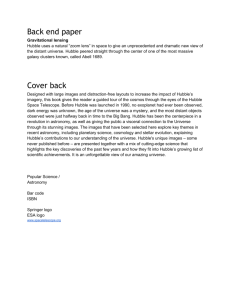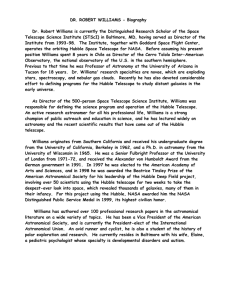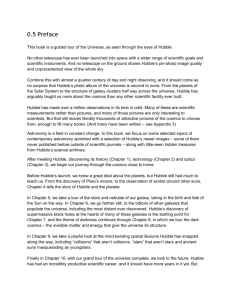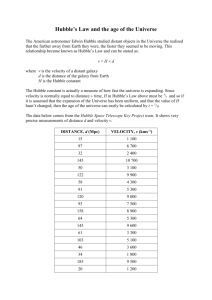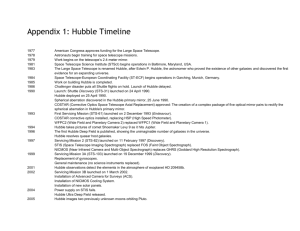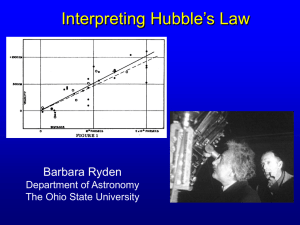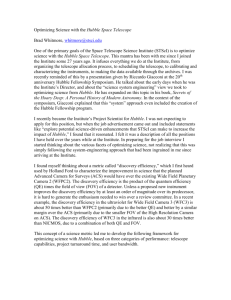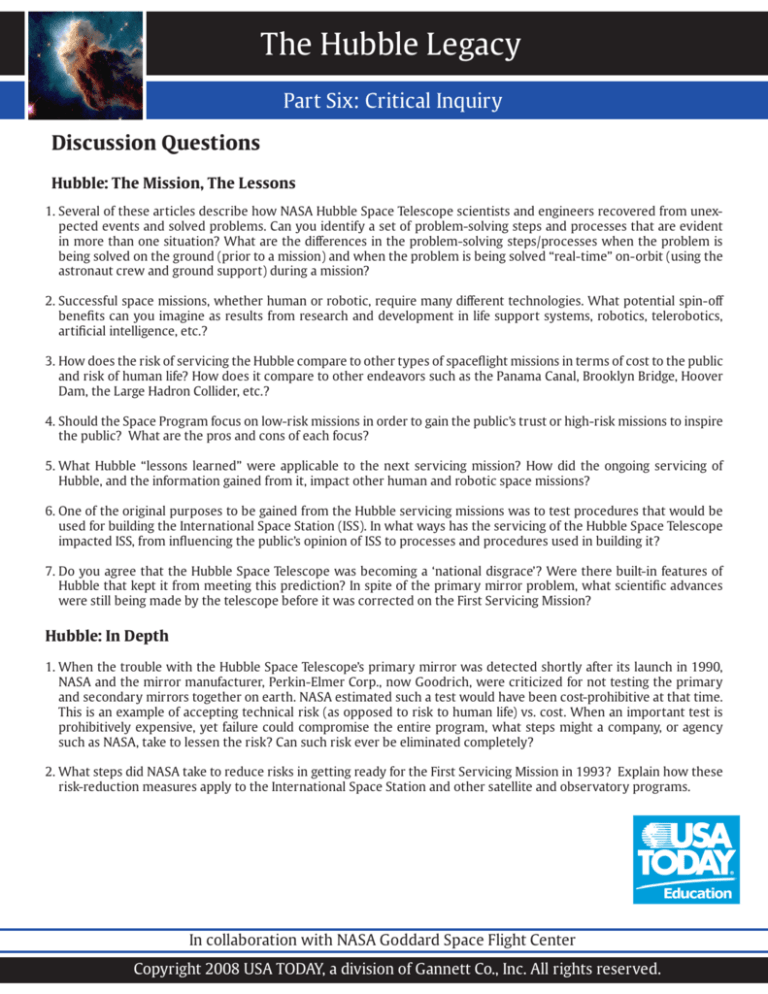
The Hubble Legacy
Part Six: Critical Inquiry
Discussion Questions
Hubble: The Mission, The Lessons
1. Several of these articles describe how NASA Hubble Space Telescope scientists and engineers recovered from unexpected events and solved problems. Can you identify a set of problem-solving steps and processes that are evident
in more than one situation? What are the differences in the problem-solving steps/processes when the problem is
being solved on the ground (prior to a mission) and when the problem is being solved “real-time” on-orbit (using the
astronaut crew and ground support) during a mission?
2. Successful space missions, whether human or robotic, require many different technologies. What potential spin-off
benefits can you imagine as results from research and development in life support systems, robotics, telerobotics,
artificial intelligence, etc.?
3. How does the risk of servicing the Hubble compare to other types of spaceflight missions in terms of cost to the public
and risk of human life? How does it compare to other endeavors such as the Panama Canal, Brooklyn Bridge, Hoover
Dam, the Large Hadron Collider, etc.?
4. Should the Space Program focus on low-risk missions in order to gain the public’s trust or high-risk missions to inspire
the public? What are the pros and cons of each focus?
5. What Hubble “lessons learned” were applicable to the next servicing mission? How did the ongoing servicing of
Hubble, and the information gained from it, impact other human and robotic space missions?
6. One of the original purposes to be gained from the Hubble servicing missions was to test procedures that would be
used for building the International Space Station (ISS). In what ways has the servicing of the Hubble Space Telescope
impacted ISS, from influencing the public’s opinion of ISS to processes and procedures used in building it?
7. Do you agree that the Hubble Space Telescope was becoming a ‘national disgrace’? Were there built-in features of
Hubble that kept it from meeting this prediction? In spite of the primary mirror problem, what scientific advances
were still being made by the telescope before it was corrected on the First Servicing Mission?
Hubble: In Depth
1. When the trouble with the Hubble Space Telescope’s primary mirror was detected shortly after its launch in 1990,
NASA and the mirror manufacturer, Perkin-Elmer Corp., now Goodrich, were criticized for not testing the primary
and secondary mirrors together on earth. NASA estimated such a test would have been cost-prohibitive at that time.
This is an example of accepting technical risk (as opposed to risk to human life) vs. cost. When an important test is
prohibitively expensive, yet failure could compromise the entire program, what steps might a company, or agency
such as NASA, take to lessen the risk? Can such risk ever be eliminated completely?
2. What steps did NASA take to reduce risks in getting ready for the First Servicing Mission in 1993? Explain how these
risk-reduction measures apply to the International Space Station and other satellite and observatory programs.
In collaboration with NASA Goddard Space Flight Center
Copyright 2008 USA TODAY, a division of Gannett Co., Inc. All rights reserved.
The Hubble Legacy
Part Six: Critical Inquiry
Hubble: In Depth (continued)
3. The article “Hubble: Astronomy’s time machine” touches on the decision to make Hubble serviceable by space-suited
astronauts operating from the Space Shuttle. Many astronomers would have preferred to put Hubble in a much higher
orbit, as are the other NASA Great Observatories. Discuss the costs of making Hubble serviceable. What would have
been the positive and negative results if Hubble had been put into a higher orbit that the Shuttle could not reach?
4. Take a look at current and future Great Observatory-type telescope missions and the different orbits they are in. What
factors determine the orbit necessary for each? What are the advantages of having observatories in different types of
orbits?
5. What might be the implications if the Orion Crew Exploration Vehicle (CEV) is capable of traveling to some of these
orbits, keeping in mind that we have now performed many kinds of repairs on Hubble which were not originally anticipated with pre-planned “built-in” features?
The Hubble Spirit
Less than three weeks prior to a scheduled October 2008 launch date for NASA’s space shuttle Atlantis’ STS-125 mission
to service the Hubble Space Telescope for the fifth servicing mission, a significant Hubble anomaly occurred on orbit.
This caused a delay of the mission so that the problem could be properly understood, analyzed and solved. The “A” side
(there are two operating electronic sides (A and B)) of the science instrument command and data handling (SI C&DH)
unit had failed, affecting the storage and transmittal of data from Hubble to Earth. Hubble’s instruments automatically
went into safe mode.
In groups of three, research the impact of this event and develop three possible options for addressing the problem.
Consider the impact of each of these plans on the objectives for the STS-125 servicing mission to Hubble and the overall
objectives of the telescope. Discuss the potential impacts, advantages and disadvantages of each plan on the Hubble
Space Telescope servicing mission and the telescope’s operations. Finally, present a justification for your selection of the
best option among the three.
Page 2
In collaboration with NASA Goddard Space Flight Center
Copyright 2008 USA TODAY, a division of Gannett Co., Inc. All rights reserved.
The Hubble Legacy
Part Six: Critical Inquiry
Internet Resources
e NASA Home Page:
www.nasa.gov
e Hubble Servicing Mission 4:
www.nasa.gov/hubble
e NASA Hubble Program Main Page:
www.nasa.gov/mission_pages/hubble/main/index.html
e Introduction to Hubble Servicing Missions:
http://hubble.nasa.gov/missions/intro.php
e NASA: A Brief History of the Hubble Space Telescope:
http://history.nasa.gov/hubble/index.html
e NASA Hubble Education Resources:
www.nasa.gov/education/hubble
e Space Telescope Science Institute Office of Public Outreach:
http://oposite.stsci.edu
e Space Telescope Science Institute Hubble Essentials/General Interest:
http://hubblesite.org
e The Hubble Heritage Project:
http://heritage.stsci.edu
e The European Home Page for the NASA/ESA Hubble Space Telescope:
www.spacetelescope.org/about/history
e Books about Edwin Hubble:
www.edwinhubble.com
e The Best of the Hubble Telescope - Links to Hubble Images:
http://seds.org/hst/hst.html
e The Planetary Society - Space Topics Hubble Space Telescope:
http://www.planetary.org/explore/topics/hubble/
All photos in the left “ears” of “The Hubble Legacy” are from the Hubble Space Telescope, Courtesy of NASA
Page 3
In collaboration with NASA Goddard Space Flight Center
Copyright 2008 USA TODAY, a division of Gannett Co., Inc. All rights reserved.
The Hubble Legacy
Part Six: Critical Inquiry
Contributing Experts:
Dr. Jeffrey A. Hoffman - Astronaut, Professor of the Practice of Aerospace Engineering, Massachusetts Institute of
Technology, Department of Aeronautics and Astronautics;
Jeff has a bachelor’s degree in astronomy from Amherst College, a master’s degree in materials science from Rice University and a doctorate in astrophysics from Harvard University.
Jeff ’s fourth space flight was as an EVA crewmember on Hubble’s first servicing mission in 1993 (STS-61). He was one
of the four astronauts who performed a record five space walks, and has logged more than 1,211 hours and 21.5 million
miles in space.
Paul Richards - Astronaut, Hubble Manager/Engineer, Observatory Manager NASA Goddard Space Flight Center
Paul has a bachelor’s degree in mechanical engineering from Drexel University and a master’s degree in mechanical engineering. from the University of Maryland.
Paul was Senior EVA Tool Development Engineer for the Hubble Space Telescope Servicing Project; Project Manager for
HST EVA crew aids and tools and Program Manager for HST EVA hardware. He also served as systems engineering support
for the HST WETF/NBS Servicing Mission Simulations as a utility diver and EMU suited subject.
Dr. Kathryn Thornton - Astronaut, Professor and Assistant Dean for Graduate Programs, University of Virginia School
of Engineering and Applied Science
Kathy has a bachelor’s degree in physics from Auburn University and master’s and doctorate degrees in physics from the
University of Virginia.
Kathy served for 12 years as a NASA Astronaut, flying on four shuttle missions. including Hubble’s first servicing mission
in 1993 (STS-61), orbiting the Earth 256 times and traveling over 6 million miles in space.
Russell L. Werneth - Aerospace Engineer and Higher Education Advisor at NASA Goddard Space Flight Center in
Greenbelt, Maryland
Russ has bachelor’s and master’s degrees in Mechanical Engineering from the University of Maryland in College Park, MD
and a master’s degree in Engineering Administration from the George Washington University in Washington, DC.
During the past four Hubble servicing missions, Russ served as the ExtraVehicular Activity (EVA, or spacewalk) Manager
or Crew Aids and Tools Manager. His responsibilities included EVA procedures and training, as well as unique astronaut
tool design, testing, and development.
Mike Weiss - Deputy Program Manager/Technical for the Hubble Space Telescope Program. Mike has led the techni-
cal development of all Hubble servicing missions. He has worked human and robotic space missions at NASA for over 30
years. Mike holds a bachelor’s and a master’s degree in Aerospace Engineering.
Page 4
In collaboration with NASA Goddard Space Flight Center
Copyright 2008 USA TODAY, a division of Gannett Co., Inc. All rights reserved.



